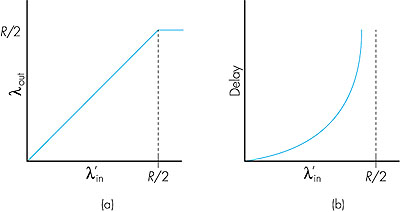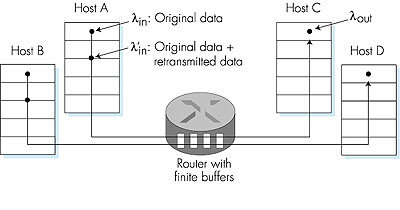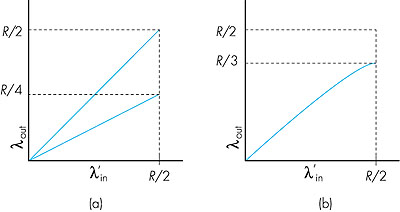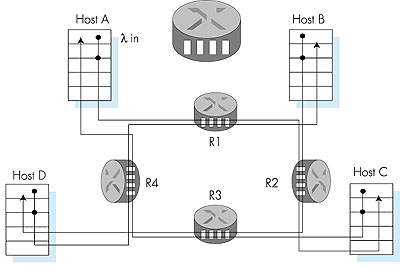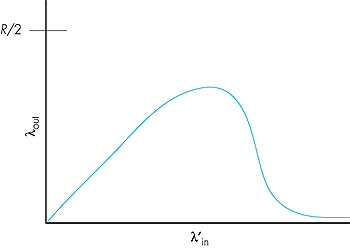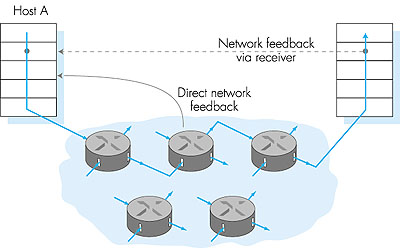3.6: Principles of Congestion Control
| In the previous
sections, we've examined both the general principles and specific TCP mechanisms
used to provide for a reliable data-transfer service in the face of packet
loss. We mentioned earlier that, in practice, such loss typically results
from the overflowing of router buffers as the network becomes congested.
Packet retransmission thus treats a symptom of network congestion (the
loss of a specific transport-layer segment) but does not treat the cause
of network congestion--too many sources attempting to send data at too
high a rate. To treat the cause of network congestion, mechanisms
are needed to throttle senders in the face of network congestion.
In this section, we consider the problem of congestion control in a general context, seeking to understand why congestion is a "bad thing," how network congestion is manifested in the performance received by upper-layer applications, and various approaches that can be taken to avoid, or react to, network congestion. This more general study of congestion control is appropriate since, as with reliable data transfer, it is high on the "top-10" list of fundamentally important problems in networking. We conclude this section with a discussion of congestion control in the ABR service in asynchronous transfer mode (ATM) networks. The following section contains a detailed study of TCP's congestion-control algorithm. 3.6.1: The Causes and the Costs of CongestionLet's begin our general study of congestion control by examining three increasingly complex scenarios in which congestion occurs. In each case, we'll look at why congestion occurs in the first place and at the cost of congestion (in terms of resources not fully utilized and poor performance received by the end systems).Scenario 1: Two Senders, a Router with Infinite Buffers We begin by considering perhaps the simplest congestion scenario possible: two hosts (A and B) each have a connection that shares a single hop between source and destination, as shown in Figure 3.41.
Let's assume
that the application in Host A is sending data into the connection (for
example, passing data to the transport-level protocol via a socket) at
an average rate of Figure 3.42 plots the performance of Host A's connection under this first scenario. The left graph plots the per-connection throughput (number of bytes per second at the receiver) as a function of the connection sending rate. For a sending rate between 0 and R/2, the throughput at the receiver equals the sender's sending rate--everything sent by the sender is received at the receiver with a finite delay. When the sending rate is above R/2, however, the throughput is only R/2. This upper limit on throughput is a consequence of the sharing of link capacity between two connections. The link simply cannot deliver packets to a receiver at a steady-state rate that exceeds R/2. No matter how high Hosts A and B set their sending rates, they will each never see a throughput higher than R/2.
Achieving a per-connection throughput of R/2 might actually appear to be a "good thing," as the link is fully utilized in delivering packets to their destinations. The right-hand graph in Figure 3.42, however, shows the consequences of operating near link capacity. As the sending rate approaches R/2 (from the left), the average delay becomes larger and larger. When the sending rate exceeds R/2, the average number of queued packets in the router is unbounded, and the average delay between source and destination becomes infinite (assuming that the connections operate at these sending rates for an infinite period of time). Thus, while operating at an aggregate throughput of near R may be ideal from a throughput standpoint, it is far from ideal from a delay standpoint. Even in this (extremely) idealized scenario, we've already found one cost of a congested network--large queuing delays are experienced as the packet-arrival rate nears the link capacity. Scenario 2: Two Senders, a Router with Finite Buffers Let us now slightly
modify scenario 1 in the following two ways (see Figure 3.43). First, the
amount of router buffering is assumed to be finite. Second, we assume that
each connection is reliable. If a packet containing a transport-level segment
is dropped at the router, it will eventually be retransmitted by the sender.
Because packets can be retransmitted, we must now be more careful with
our use of the term "sending rate." Specifically, let us again denote the
rate at which the application sends original data into the socket by
The performance
realized under scenario 2 will now depend strongly on how retransmission
is performed. First, consider the unrealistic case that Host A is able
to somehow (magically!) determine whether or not a buffer is free in the
router and thus sends a packet only when a buffer is free. In this case,
no loss would occur,
Consider next
the slightly more realistic case that the sender retransmits only when
a packet is known for certain to be lost. (Again, this assumption is a
bit of a stretch. However, it is possible that the sending host might set
its timeout large enough to be virtually assured that a packet that has
not been acknowledged has been lost.) In this case, the performance might
look something like that shown in Figure 3.44(b). To appreciate what is
happening here, consider the case that the offered load, Finally, let us consider the case that the sender may timeout prematurely and retransmit a packet that has been delayed in the queue, but not yet lost. In this case, both the original data packet and the retransmission may both reach the receiver. Of course, the receiver needs but one copy of this packet and will discard the retransmission. In this case, the "work" done by the router in forwarding the retransmitted copy of the original packet was "wasted," as the receiver will have already received the original copy of this packet. The router would have better used the link transmission capacity to send a different packet instead. Here then is yet another cost of a congested network--unneeded retransmissions by the sender in the face of large delays may cause a router to use its link bandwidth to forward unneeded copies of a packet. The lower curve in Figure 3.44(a) shows the throughput versus offered load when each packet is assumed to be forwarded (on average) twice by the router. Since each packet is forwarded twice, the throughput achieved will be given by the line segment in Figure 3.44(a) with the asymptotic value of R/4. Scenario 3: Four Senders, Routers with Finite Buffers, and Multihop Paths In our final
congestion scenario, four hosts transmit packets, each over overlapping
two-hop paths, as shown in Figure 3.45. We again assume that each host
uses a timeout/ retransmission mechanism to implement a reliable data transfer
service, that all hosts have the same value of
Let us consider
the connection from Host A to Host C, passing through Routers R1 and R2.
The A-C connection shares router R1 with the D-B connection and shares
router R2 with the B-D connection. For extremely small values of Having considered
the case of extremely low traffic, let us next examine the case that
The reason for the eventual decrease in throughput with increasing offered load is evident when one considers the amount of wasted "work" done by the network. In the high-traffic scenario outlined above, whenever a packet is dropped at a second-hop router, the "work" done by the first-hop router in forwarding a packet to the second-hop router ends up being "wasted." The network would have been equally well off (more accurately, equally bad off) if the first router had simply discarded that packet and remained idle. More to the point, the transmission capacity used at the first router to forward the packet to the second router could have been much more profitably used to transmit a different packet. (For example, when selecting a packet for transmission, it might be better for a router to give priority to packets that have already traversed some number of upstream routers.) So here we see yet another cost of dropping a packet due to congestion--when a packet is dropped along a path, the transmission capacity that was used at each of the upstream routers to forward that packet to the point at which it is dropped ends up having been wasted. 3.6.2: Approaches toward Congestion ControlIn Section 3.7, we'll examine TCP's specific approach towards congestion control in great detail. Here, we identify the two broad approaches that are taken in practice toward congestion control, and discuss specific network architectures and congestion-control protocols embodying these approaches.At the broadest level, we can distinguish among congestion-control approaches based on whether or not the network layer provides any explicit assistance to the transport layer for congestion-control purposes:
3.6.3: ATM ABR Congestion ControlOur detailed study of TCP congestion control in Section 3.7 will provide an in-depth case study of an end-end approach toward congestion control. We conclude this section with a brief case study of the network-assisted congestion-control mechanisms used in ATM ABR service. ABR has been designed as an elastic data transfer service in a manner reminiscent of TCP. When the network is underloaded, ABR service should be able to take advantage of the spare available bandwidth; when the network is congested, ABR service should throttle its transmission rate to some predetermined minimum transmission rate. A detailed tutorial on ATM ABR congestion control and traffic management is provided in [Jain 1996].Figure 3.48 shows the framework for ATM ABR congestion control. In our discussion below we adopt ATM terminology (for example, using the term "switch" rather than "router," and the term "cell" rather than "packet"). With ATM ABR service, data cells are transmitted from a source to a destination through a series of intermediate switches. Interspersed with the data cells are so-called resource-management cells, RM cells; we will see shortly that these RM cells can be used to convey congestion-related information among the hosts and switches. When an RM cell is at a destination, it will be "turned around" and sent back to the sender (possibly after the destination has modified the contents of the RM cell). It is also possible for a switch to generate an RM cell itself and send this RM cell directly to a source. RM cells can thus be used to provide both direct network feedback and network-feedback-via-the-receiver, as shown in Figure 3.48.
ATM ABR congestion control is a rate-based approach. That is, the sender explicitly computes a maximum rate at which it can send and regulates itself accordingly. ABR provides three mechanisms for signaling congestion-related information from the switches to the receiver:
|
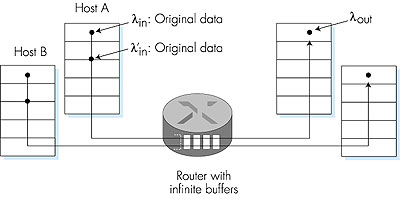
 in
bytes/sec. These data are "original" in the sense that each unit of data
is sent into the socket only once. The underlying transport-level protocol
is a simple one. Data is encapsulated and sent; no error recovery (for
example, retransmission), flow control, or congestion control is performed.
Host B operates in a similar manner, and we assume for simplicity that
it too is sending at a rate of
in
bytes/sec. These data are "original" in the sense that each unit of data
is sent into the socket only once. The underlying transport-level protocol
is a simple one. Data is encapsulated and sent; no error recovery (for
example, retransmission), flow control, or congestion control is performed.
Host B operates in a similar manner, and we assume for simplicity that
it too is sending at a rate of 